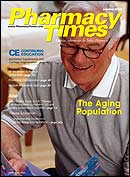Case Studies
Dr. Schlesselman is an assistant clinical professor at the University of Connecticut School of Pharmacy.
CASE ONE
Two patients arrive at thewalk-in clinic located at thelocal pharmacy. Both patientswish to be evaluatedfor their cold symptoms.While waiting, the patientschat about their symptomsand how long they havebeen "suffering."
The first patient to be seenby the clinician is a 70-year-old woman. Her medical historyis significant for congestive heart failure and chronic bronchitis.After examining the patient, the clinician suspectsshe has developed acute bronchitis. The clinician prescribesmultiple medications and recommends that the woman follow-up with her primary care provider.
The second patient is a 25-year-old man. He has no significantmedical history. Having witnessed the first patientleave with multiple prescriptions, the man enters the examroom believing he will receive an equal number of prescriptionmedications. After examining the man, the clinician prescribesa cough syrup.
The patient cannot believe that he did not receive asmany prescriptions as the first patient! When he brings theprescription over to the pharmacy, he complains to thepharmacist that he and the first patient had the same symptoms.Despite this fact, he only received a cough syrup,whereas the other patient had "a stack of prescriptions."The man then exclaims, "I bet she even had a prescriptionfor an antibiotic! That is what I need." The first patient hearsthe man's comments and confirms that she did indeedreceive a prescription for an antibiotic.
How can the pharmacist explain the differences in prescriptions?
CASE TWO
MT, a 50-year-old woman,presents to the pharmacy andasks to speak with the pharmacist.When the pharmacistenters the counseling room,MT explains that she wouldlike the pharmacist to recommendan herbal product to"boost her energy level." Sheexplains to the pharmacist that she has been extremelyfatigued and lethargic for the last few months. Although shedoes not have an appetite, she is gaining weight. During theirconversation, the pharmacist also notices that MT's skinappears dry and scaly. Also, her hair appears dry and brittle,and her nails appear thick and brittle.
The pharmacist reviews MT's medication profile, notingthat MT currently does not use any chronic medications.She asks if MT has a history of hypothyroidism. Although MTdenies ever being diagnosed with hypothyroidism, she saysthat her mother has it.
What signs and symptoms of hypothyroidism does MTexhibit? What risk factors does she have?
ANSWERS
CASE ONE:
The common cold is caused by a virus. Viral infections do not require treatment with antibiotics. How the infection resolvesor progresses can vary by patient. Even with the same symptoms and duration of illness, some patients are more likely to develop complications. In particular,patients of extremes in age or with chronic medical conditions are at risk of increased morbidity. In this situation, the woman's age and chronic illnessesincreased her risk of morbidity. She no longer had a simple cold but rather had developed bronchitis, which required antibiotics. The otherwise healthy man'sviral infection had not progressed.
CASE TWO:
In patients with hypothyroidism, the symptoms they exhibit are all related to the slowing of metabolisms. Common symptoms include fatigue,lethargy, depression, decreased appetite, dry skin, brittle hair, thick nails, and weight gain. Hypothyroidism is more common in women, particularly aged 50and older. Family history also may play a role.
function showAnswer() {document.getElementById("answer").style.display = 'block';document.getElementById("link").style.display = 'none';}

